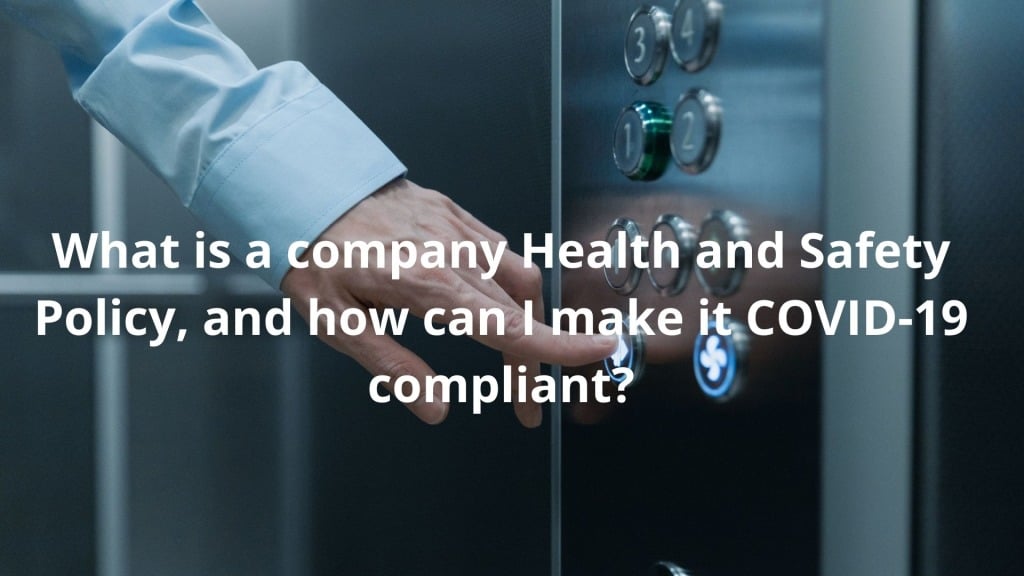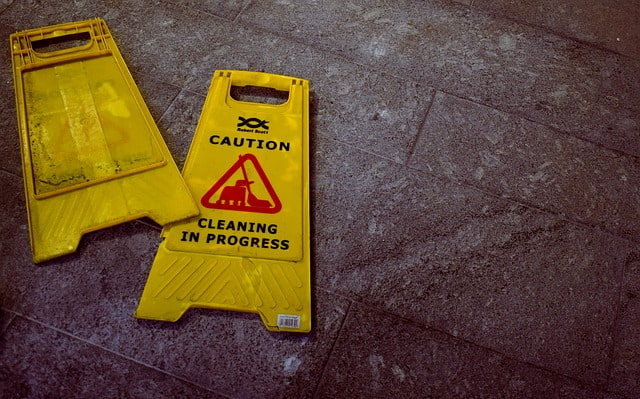Creating a COVID-19 Complaint Company Healthy and Safety Policy: A Step-by-Step Guide
31 Jan 2023
24 Jun 2021
min read

Regardless of whether you are a brand-new start-up or multinational corporation, it goes without saying that health and safety in the workplace is a top concern, particularly during the COVID-19 pandemic. A health and safety policy is a key document that sets out the procedures and practices all employees must adhere to. It clarifies the various responsibilities the company has as an employer and delineates the duties employees must follow to help mitigate workplace injury or risk. Fundamentally, the document contains the company’s commitment to maintaining a healthy and safe workplace, and details how the company seeks to put that vision into action.
Whilst different jurisdictions have varying legal requirements, the core elements of good health and safety policies remain similar across the board. Here is everything you need to know about implementing a good health and safety policy.

What is a health and safety policy?
A health and safety policy is a document written by a company (the ‘employer’) which details the company’s commitment to upholding the health and safety of employees in the workplace. It expresses the company’s commitment to mitigating risk and/or hazards and the specific procedures to be followed by both parties to achieve this goal.
Creating a health and safety policy is the employer’s responsibility. The employer should therefore ensure that the policy is written in compliance with the legal duties and requirements of the jurisdiction.
Do I need a health and safety policy?
Yes – if you are an employer, you will need to create a health and safety policy to help manage risks and expectations in the workplace. It does not matter whether you are a small or large organisation; this is a legal requirement for employers.
You might also want to look into jurisdictional guidelines where there might be some exceptions. In the UK, for example, employers only need to create a health and safety policy where the company has five or more employees.

What is the purpose of a health and safety policy?
There are various reasons why you need a health and safety policy, regardless of the size or nature of your business:
- To prevent occupational incidents in the workplace from unfolding
- Identifies the necessary risks and precautions to be taken
- Sets out the expectations and responsibilities for members of the company to help contribute to a healthy and safe workplace
- Delineates the scope of legal duties members of the company should be held accountable for
- Outlines the health and safety system in place for risk management and protecting employees
- To prove the company’s commitment to providing the necessary information, training, and support to employees with respect to health and safety risks that may arise from their work
What are the components of a health and safety policy?
While there is no set structure for your health and safety policy, your statement should cover four broad areas such that it meets the legal requirements of your jurisdiction. These four areas will be explored below respectively, with some suggestions on what to cover:
1. Statement of intent
2. Organisation for implementing and carrying out the policy
3. The arrangements for carrying out the policy
4. Revision and Explanation of the Policy
Statement of intent and general policy
This should be placed in the first part of the policy.
It should detail the company’s general objectives for health and safety at work and declare the commitments it has to maintain a good working environment.
Important details to incorporate include employee expectations, the employer’s intention and commitment, facilities and/or resources available to members of the company, as well as a reference to the necessity for compliance with the policy. The aim/purpose of the policy should also be listed.
Organisation for implementing and carrying out the policy
Once you have given a broad overview of the purpose of the policy, employee expectations and what the policy sets out to achieve, you will then need to detail how responsibilities will be allocated among members of the company.
Delegation of responsibilities/duties should be clear, such that each member of the company knows what they are being held accountable for.
The arrangements for carrying out the policy
This section deals with how those responsibilities and duties are carried out in practice. This involves details on the system in place, such as emergency and training procedures, first-aid, hygienic remarks, accident reporting procedures, consequences of policy violations, etc.

Revision and Explanation of the Policy
This should be the final section of your policy. It should provide detail as to the most recent update date of the policy and a clause to the effect that the company reserves the right to amend the policy depending on business needs.
How often should my health and safety policy be reviewed?
While there is no set requirement specifying how often the health and safety policy should be updated, the Health and Safety Executive, for example, recommends a review to be undertaken on an annual basis.
With that being said, the more you review it, the more accurate the policy will reflect your current workplace. As such, it is a good idea to review your policy whenever you feel is needed.
How can I make my health and safety policy COVID-19 compliant?
COVID-19 has the potential to cause severe workplace outbreaks, meaning that planning for COVID-19 must be a significant part of and accounted for in every health and safety policy. Employers can make their health and safety policy COVID-19 compliant by including a section of COVID-specific guidelines and procedures in the existing version of your policy.
This requires existing guidelines to be updated with information that addresses exposure risks, sources of exposure, transmission methods and the relevant health and safety precautions needed to prevent the spread of COVID-19.

To do so, employers should determine what measures are ‘reasonably practicable’ in preventing the spread of COVID-19. The unpredictable nature of the pandemic means that COVID outbreak conditions are continually subject to change, meaning that employers should consider the circumstances at the time whilst planning new guidelines. These guidelines can always be changed if needed as circumstances change.
Employers should also consider guidance from local and/or federal levels as well as that from health agencies whilst creating a COVID 19 compliant health and safety policy. Some basic COVID-19 guidelines that should be incorporated include:
- Safe work practices and basic infection prevention measures (e.g.: use of masks and disinfection procedures)
- Personal Protective Equipment (PPE)
- Self-isolation guidelines for workers with potential COVID-19 infections/exposure
- Administrative controls
- Engineering or environmental controls (e.g.: installation of new ventilation)
- Workplace flexibilities
- Corporate policies or programs for the prevention of COVID-19 (e.g.: COVID vaccination – see our policy template here.)
When should my health and safety policy be updated?
It is likely that new risks or practices will be introduced into the workplace at some point in time as your business undergoes changes. In this case, you would need to review your current health and safety policy and determine whether it contains the necessary precautions for mitigating risks and maintaining a safe environment. New precautions and information may need to be incorporated into the document to ensure that this happens if the current policy does not reflect those changes.
It is your duty as an employer to ensure that all the precautions are up to date. Each time an aspect of health and safety is altered, it is very important that this is always reflected in the revised policy and that all employees are notified of every change.
Since there are many factors that can affect the level of health and safety within companies/the workplace, many companies fail to update their policy as often as they should. Here are a few strong indications that point to the fact that your policy needs to be reviewed and updated:
1. Company growth or expansion
Alongside company growth often comes new premises or locations to account for that expansion. If operations have expanded into new places where workplace conditions differ, you must ensure that all the new hazards and risks in that new environment are specified in your updated health and safety policy.
2. New equipment or procedures
Whenever new equipment or procedures are introduced to the workplace, you must ensure that the safety and risk concerns surrounding them are fully accounted for. This is the case because new equipment or procedures often involve additional hazards that require different safety practices.
3. Time
As we briefly touched on, whilst there is no set time for updating and reviewing your health and safety policy, you should aim to look through it as needed, or at the very least, on an annual basis.
If over a year has passed since your last review, this stands as a strong indication that you need to review it and determine whether it is still suitable given the current state of the workplace.
4. An occupational incident has occurred
After every incident, your health and safety policy should be reviewed with that incident in mind. You should look at the current health and safety system and determine whether there is any aspect you need to change or room for improvement given the incident’s occurrence.
You should also look at the current procedures to try and understand why the incident occurred. Was it due to a shortcoming in your policy? Or perhaps, gaps in your policy which you left inadvertently?
Regardless, it should be reviewed and updated to prevent incidents from occurring again.
5. Complaints
If your employees are raising concerns or complaints regarding a hazard, this is a strong sign that you should review your existing policy.
6. Significant events (i.e.: COVID-19)
You will likely need to review and update your company's health and safety policy when an unforeseen event or happening such as COVID-19 occurs.
7. Legal or regulatory changes
It is important that your health and safety policy always complies with specific jurisdictional requirements. This means that whenever there are updates to health and safety legislation, these updates must be accounted for in your policy.
Template(s)
Accidents can be serious, meaning that there is no room for ambiguities within your health and safety policy.
To help you with this, we created two customisable templates for you to use – one standard one, which you can find here, and a COVID-19 compliant version, here.
Please note that this is just a general summary of the position under common law and does not constitute legal advice. As the laws of each jurisdiction may be different, you may want to speak to your lawyer.
Keywords:

